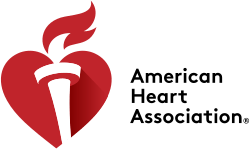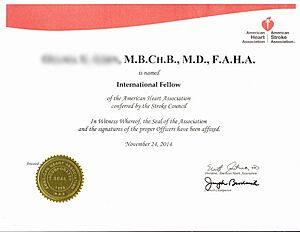American Heart Association facts for kids
 |
|
| Formation |
|
|---|---|
| Founder | Paul Dudley White, Dr. Lewis A. Conner, Dr. Robert H. Halsey, Dr. James B. Herrick, Dr. Hugh McCulloch, and Dr. Joseph Sailer |
| Type | Nonprofit |
| Legal status | 501(c)(3) |
| Purpose | "To be a relentless force for a world of longer, healthier lives" |
| Headquarters | 7272 Greenville Avenue, Dallas, Texas |
| Location | |
|
Key people
|
|
The American Heart Association (AHA) is a nonprofit organization in the United States that works to fight cardiovascular disease and stroke. This means they help people live longer, healthier lives.
The AHA does this by funding medical research to find new treatments. They also teach people how to live a healthy lifestyle and take care of their hearts. The organization is known for creating important guidelines for doctors and the public on heart health, basic life support (like CPR), and preventing strokes.
The AHA was started in 1924 and is now based in Dallas, Texas. Its mission is "To be a relentless force for a world of longer, healthier lives."
History of the AHA
Early Years
The American Heart Association was formed in 1924 by a group of six heart doctors, called cardiologists. They wanted to create a group where doctors could share knowledge about heart disease.
A big moment for the AHA happened in 1949. A popular radio show called Truth or Consequences held a contest that raised $1.5 million for the organization. This was a huge amount of money at the time. It allowed the AHA to start funding major scientific research and public health programs.
Since then, the AHA has funded over $5 billion in research for heart, brain, and blood vessel health. Today, it has millions of volunteers working to improve heart health for everyone.
Creating Health Guidelines
In the 1950s and 1960s, the AHA began publishing guidelines to help people stay healthy. They were one of the first groups to say that diet and exercise were important for preventing heart disease.
By 1961, their advice included:
- Keep a healthy weight.
- Get moderate exercise, like walking.
- Eat less fat and cholesterol.
- Eat more healthy fats, like those found in vegetable oils.
This advice helped shape how people think about healthy living.
Recent History
In 1998, the AHA created the American Stroke Association to focus on preventing strokes and helping people recover from them.
In 2004, the AHA launched its famous "Go Red for Women" campaign. This program teaches women about their unique risks for heart disease and what they can do to stay healthy.
The AHA has also worked to make CPR easier for everyone to learn. In 2008, they began recommending "hands-only" CPR for bystanders. This method is simpler because it focuses only on chest compressions and removes rescue breaths.
In 2017, the AHA helped update the definition of high blood pressure. This change helps doctors find and treat high blood pressure earlier, which can prevent serious health problems.
The AHA celebrated its 100th birthday in June 2024. It is the oldest and largest volunteer group in the U.S. dedicated to fighting heart disease and stroke.
What the AHA Focuses On
The American Heart Association works in many areas to improve health. Here are some of their most important projects.
Teaching Life-Saving Skills
Be the Beat
The AHA wants young people to know how to save a life. The "Be the Beat" campaign teaches teenagers the basics of CPR and how to use an automated external defibrillator (AED). An AED is a device that can help restart a heart during a cardiac arrest.
Nation of Lifesavers
This program, started in 2023, aims to make sure more people are ready to act in a cardiac emergency. NFL player Damar Hamlin, who survived a cardiac arrest during a game, has worked with the AHA to promote this cause. He helps raise awareness about how important it is for people to know CPR.
Promoting Healthy Habits
Life’s Essential 8
The AHA created a list of eight key things for good heart health, called "Life's Essential 8." These are:
- Eating a healthy diet
- Being physically active
- Not smoking
- Getting enough sleep
- Keeping a healthy weight
- Controlling cholesterol
- Managing blood pressure
- Managing blood sugar
Know Diabetes By Heart
This program is a partnership with the American Diabetes Association. It raises awareness that people with diabetes have a higher risk of heart disease. It teaches them how to manage both conditions.
Fighting Sugary Drinks
The AHA supports policies that help reduce how many sugary drinks people consume. They have supported taxes on these drinks because too much sugar can lead to health problems like obesity and heart disease.
Helping Everyone Get Healthy
The AHA believes everyone deserves a chance to live a long, healthy life. They have programs to help communities that face more barriers to good health.
- Hispanic Serving Institution Scholars Program: This program helps Hispanic students who are studying to become doctors, nurses, and scientists.
- Historically Black Colleges and Universities (HBCU) Scholars Program: This program helps Black students get experience in science and medicine.
- HeartCorps: This program sends health workers to rural areas in the U.S. to help people learn about heart health and get the care they need.
Joining the AHA
Doctors, scientists, and other health professionals can become special members of the AHA called Fellows. This title shows that they are experts in heart disease and stroke and have made important contributions to the field.
Nancy Brown is the CEO of the American Heart Association. The volunteer president is Keith B. Churchwell.
See also
 In Spanish: Asociación Estadounidense del Corazón para niños
In Spanish: Asociación Estadounidense del Corazón para niños
- American College of Cardiology
- American Heart Association Paul "Bear" Bryant Awards
- American Heart Month
- Automated external defibrillator (AED)
- American Stroke Association




